(233 products available)
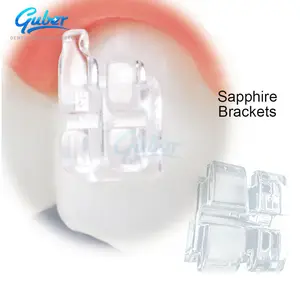



































































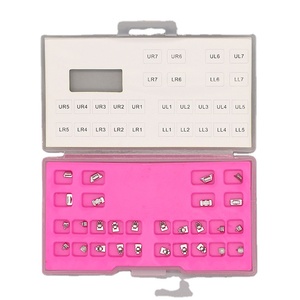
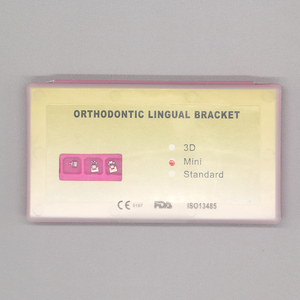
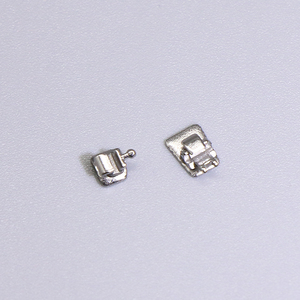
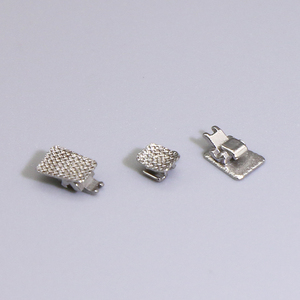

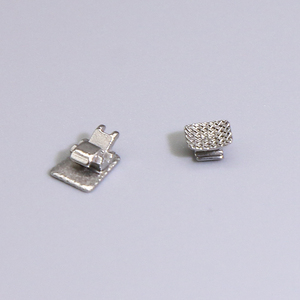




































































































Orthodontic brackets are tools used in dentistry to straighten bent teeth. There are many types of brackets, and they all have strengths and weaknesses. This part covers the different brackets dentists commonly use.
Metal braces are the most common type of orthodontic appliance. These brackets use stainless steel, titanium, and nickel alloys. They are durable, cost-effective, and resistant to staining. Metal brackets also provide the strength needed to handle the pressure of realignment. However, they can sometimes cause discomfort and are more noticeable than other types.
Ceramic brackets are popular because people think they are less noticeable than metal. This is because they use clear or tooth-colored materials. It makes them blend in with the person's natural teeth. However, these brackets are more delicate and may require more frequent repairs. These repairs often include changing the adhesive that holds them on.
Lingual brackets are glued on the back of the teeth, making them invisible from the front. This is a good option for adults and teens who want orthodontic treatment without visible hardware. However, lingual brackets may take longer to install and adjust than other types. They can also be more expensive.
Self-ligating brackets use a special clip instead of rubber bands to hold the archwire in place. This clip reduces friction and allows teeth to move more easily. Self-ligating brackets are efficient and can shorten treatment time by up to 6 months. This makes them a great option for busy patients.
Different materials are used to make orthodontic brackets. Each material has its own benefits. The next section describes these materials in detail.
Stainless steel is the most common material for metal brackets. It is resistant to rust and very strong. Brackets made of stainless steel are durable and can handle the pressure of teeth moving. It also fits well with other braces parts to give a good result during treatment. However, they are more visible on the teeth than other options.
Ceramic brackets are made of glass-like materials that can withstand the forces during orthodontic treatment. These materials are durable enough for daily wear and tear in the mouth. The biggest benefit of ceramic is that it can be difficult to notice. This makes it a popular choice for people who want a more discreet option. The main drawback is that they tend to be more fragile than metal brackets and can break easily.
Composite brackets are made of plastic-like materials that are affordable and easy to mold. They offer both strength and flexibility. This makes them a very versatile option. They are also lightweight and may be less likely to irritate the gums. However, composites are not as strong as metal or ceramic and may wear down more quickly.
If self-ligating brackets have NiTi (nickel titanium) wires, they will not break when deformed during treatment. These wires have superelasticity, so they can go back to their normal shape over time. Patients will feel less force because the wires are flexible.
Choosing the right top orthodontic bracket for clients can be tricky. So healthcare workers should think about these key factors to pick the best brackets for their clients. They should also make sure the braces tools they supply have these key features.
Healthcare workers should pick brackets that can handle daily use and have the stress of teeth movement. Durable brackets mean fewer breaks and repairs. This also gives clients a smoother experience overall.
The bracket material should be smooth and comfortable in the mouth. Workers should avoid brackets that cause gum irritation. Workers should also avoid heavy brackets because they can make patients feel uncomfortable.
Healthcare workers should pick stain-resistant brackets, especially ceramic ones. Low-stain or stain-resistant brackets will be easier for the client to manage. It also means that clients can have a more discreet look during treatment.
The brackets should have low maintenance needs. Some brackets require more frequent repairs like changing wires or bands. Workers should choose options that need fewer services. Self-ligating and lingual braces require fewer adjustments than traditional metal braces, so consider them.
Bracket costs will directly affect how much clients spend on braces. Metal brackets tend to be the most affordable option. But other brackets give better comfort and fewer adjustments. Workers should pick brackets that fit their clients' budgets while giving the clients the quality they need.
Workers should pay attention to the patients' personal preferences and active lifestyles. Athletes may need bite plates to protect their brackets from damage during rough contact in their sports. This small detail ensures active patients can safely get through their treatments without delaying their care.
Orthodontic brackets are often used in settings that focus on healthcare. They are all necessary tools that perform important jobs in those settings. The next section looks at the different ways top brackets are used commercially.
Holistic dentistry often uses brackets that are healthier for the body since they focus on overall wellness. They avoid metal that may cause allergies or irritation. Instead, they use options like ceramic or composite materials that are safer for patients with sensitivities. Holistic dental care aims for a natural look while promoting patients' overall wellness.
Some lingual and self-ligating brackets can help with jaw alignment issues beyond just straightening teeth. Their design lets them apply gentle pressure that can aid in correcting growth or posture problems related to the jaw. Orthodontic brackets are frequently used in combo with other tools to support patients with chronic pain or physical therapy. This is so brackets can help in managing symptoms over the long term.
Ortho brackets are necessary for cosmetic dental work that enhances the smile and boosts self-esteem. Brackets like clear or lingual are designed to be invisible or hard to see. This makes them a popular option for those who want a quick treatment while ensuring their smile stays photo-ready. These brackets are also durable, so clients do not need to worry about damaging their brackets during multiple procedures.
Some special brackets can be used to anchor screws temporarily in areas where they are most needed. These are great for patients with long or complex treatments. Workers should choose brackets that work with these anchoring tools to give clients the best care.
A1: Yes, dental tools like brackets commonly have the same standards worldwide. They are all designed according to those standards so they can work well. But there may be differences in how the tools look. For example, tools from Japan are more present in Japan. But tools from the United States tend to have more choices that are clear or hard to see through.
A2: Brackets and wires do not need to be made of the same material. Dentists can mix and match them as long as they work together well. For example, titanium brackets can go with nickel-titanium wires. But all the materials do need to be compatible. For instance, they should all be able to handle the force of the wires without causing any problems.
A3: Yes, there are metal orthodontic tools that are safer for people with metal allergies. For example, titanium brackets are great for people who have metal allergies. This is because titanium is very strong but does not cause irritation like other metals.
A4: There are brackets that struggle less with staining. Clear ceramic and plastic brackets are more likely to stain. They get stained often by things like coffee, tea, and soda. But there are also stainless steel brackets that resist stains. These metal brackets are easier to clean. They also hide stains better than other types.
A5: Workers do not need to worry about future treatments when choosing brackets. The brackets can be changed later to prepare for more complex work if the client has any. But if the client needs surgery, having the right brackets at the start of the treatment will make it easier to plan the operations.